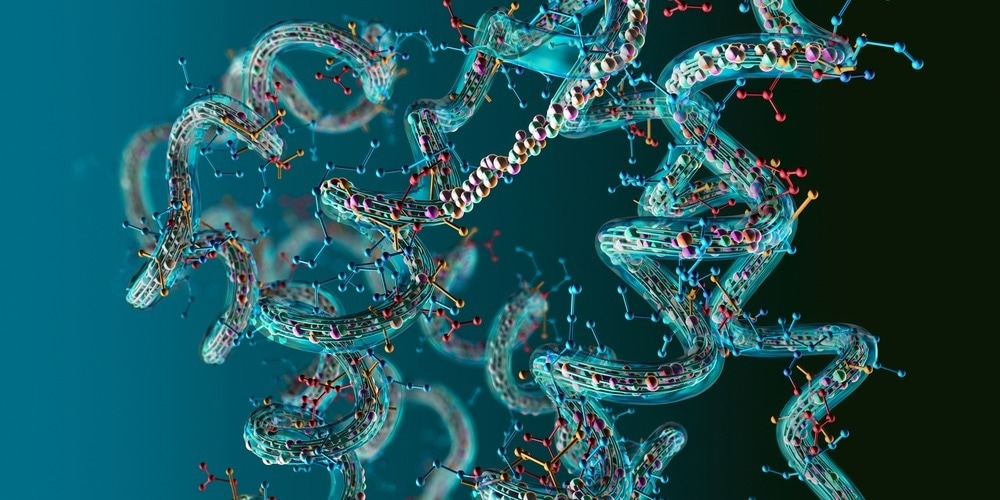Proteins are considered to be the building blocks of life. They are implicated in a range of vital biological functions, and every cell in the human body contains this class of molecule. Proteins play a key role in maintaining healthy states in the body and are also implicated in disease states.

Image Credit: Christoph Burgstedt/Shutterstock.com
Therefore, research into proteins is fundamental to gaining a deeper understanding of the pathogenesis of many diseases. Here, we explore why investigating post-translational modifications of proteins are important to understanding disease and how DIA-MS can quantify these changes.
What are Post-Translational Modifications, and Why Study Them?
Post-translational modifications (PTMs) are covalent processing events that can occur at any part of the protein's life cycle. These events alter the protein's properties by adding a modifying group of either acetyl, phosphoryl, glycosyl, or methyl to an amino acid. There are four classifications of PTMs, based on the type of modifying group that is added; they are known as acetylation, phosphorylation, hydroxylation, and methylation. PTMs increase the functional diversity of the proteome.
PTMs are vital to increasing proteomic diversity. More than 400 different types of PTM have been identified, all of which have roles in managing various aspects of protein functions. Proteins are implicated in the regulation of various cellular processes, and PTMs are key to managing these molecular regulatory mechanisms. Because PTMs have the power to alter the structure and function of a protein, disruption of PTMs can disrupt biological processes, thus leading to the establishment of disease.
For example, research has found that PTMs are associated with tumor growth, progression, and survival due to their modification of the normal functions of protein in cancerous cells.
Perhaps the most well-known research of PTMs in disease is in Alzheimer's disease. A vast body of research has shown that PTMs are implicated in the onset and progression of Alzheimer's disease. Tau tangles and senile plaques, two of the hallmarks of Alzheimer's disease, are known to result from PTMs of the amyloidβ protein precursor and tau protein.
Research has led to the characterization of these PTMs via biochemical-based methods. However, research into PTMs has the overarching limitation of lacking a molecular-based means of qualitative and quantitative analysis. Mass spectrometry (MS) and data-independent acquisition (DIA) provide a solution.
Quantifying PTMs with DIA-MS
For decades, researchers have studied PTMs. However, it is only recently, with the utilization of mass spectrometry, that the analysis of PTM profiles has been completely revolutionized, allowing for thousands of novel PTM sites to be identified.
MS is a high-throughput tool that is often used to study proteins. Proteins can be identified with this technique in a process that involves the digestion of proteins into peptides, followed by separation, fragmentation, ionization; finally, they are captured by mass spectrometers.
In recent years, proteomics techniques that leverage mass spectrometry have emerged as the preferred technique for measuring changes in PTMs. One such technique that has gained popularity utilizes immunoaffinity enrichment alongside high-resolution mass spectrometry. This method can also be coupled with DIA to produce a high-throughput, label-free PTM quantification approach.
DIA is an emerging proteomics technology used alongside MS to determine the molecular structure, where ions within a specified mass-to-charge ratio range are fragmented and analyzed by the following stage of MS.
Numerous studies have been conducted using MS alongside DIA. For example, a 2018 study applied DIA to the analysis of hippocampal synaptosome preparations of samples taken from rodents and primates. The use of DIA in this study allowed for the detection of a vast group of differentially expressed proteins between rodents and primates.
A 2021 study aimed to uncover the contribution of more than 100 independent genetic risk loci associated with schizophrenia. The team examined the neuronal phenotypes and identified three risk genes that caused similar changes in synaptic development. Running DIA analysis on neuronal cultures with each of these three individual knockdown genes identified an overlap in PTMs. The results highlighted the common cellular pathways that may explain the polygenic risk seen in schizophrenia.
DIA analysis has also been used to analyze whole cell lysates. This method has identified protein changes following the knockout of genes of interest in schizophrenia.
These results demonstrate the importance of DIA-MS in measuring PTMs. This emerging method will likely be fundamental in expanding our knowledge of the underlying biological mechanisms of various physical and psychological illnesses. It is possible that research with DIA-MS in this field will contribute to the development of novel therapeutics and diagnostics for a range of diseases.
Sources:
- Holtz, A., Basisty, N. and Schilling, B. (2021) "Quantification and identification of post-translational modifications using modern proteomics approaches," Methods in Molecular Biology, pp. 225–235. Available at: https://doi.org/10.1007/978-1-0716-1024-4_16.
- Kelley, A.R., Bach, S.B.H. and Perry, G. (2019) "Analysis of post-translational modifications in alzheimer's disease by mass spectrometry," Biochimica et Biophysica Acta (BBA) - Molecular Basis of Disease, 1865(8), pp. 2040–2047. Available at: https://doi.org/10.1016/j.bbadis.2018.11.002.
- Koopmans, F. et al. (2018) "Comparative hippocampal synaptic proteomes of rodents and primates: Differences in neuroplasticity-related proteins," Frontiers in Molecular Neuroscience, 11. Available at: https://doi.org/10.3389/fnmol.2018.00364.
- Li, K.W. et al. (2020) "Recent developments in data independent acquisition (DIA) mass spectrometry: Application of quantitative analysis of the brain proteome," Frontiers in Molecular Neuroscience, 13. Available at: https://doi.org/10.3389/fnmol.2020.564446.
- Rosato, M. et al. (2019) "Combined Cellomics and proteomics analysis reveals shared neuronal morphology and molecular pathway phenotypes for multiple schizophrenia risk genes," Molecular Psychiatry, 26(3), pp. 784–799. Available at: https://doi.org/10.1038/s41380-019-0436-y.
- Yang, Y. and Qiao, L. (2022) "Data‐independent acquisition Proteomics Methods for Analyzing Post‐translational modifications," PROTEOMICS, 23(7-8). Available at: https://doi.org/10.1002/pmic.202200046.
Further Reading
Last Updated: Jun 26, 2023